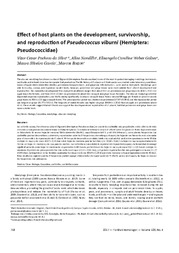Effect of host plants on the development, survivorship, and reproduction of Pseudococcus viburni (Hemiptera: Pseudococcidae).
Effect of host plants on the development, survivorship, and reproduction of Pseudococcus viburni (Hemiptera: Pseudococcidae).
Author(s): SILVA, V. C. P. da; NONDILLO, A.; GALZER, E. C. W.; BOTTON, M.
Summary: The obscure mealybug Pseudococcus viburni (Signoret) (Hemiptera: Pseudococcidae) is one of the most important damaging mealybugs in vineyards worldwide and in South American temperate fruit production. The life history of P. viburni on 3 fruit species was studied under laboratory conditions. Leaves of apple Malus domestica (Borkh.), persimmon Diospyros kaki L., and grapevine Vitis labrusca L., were used as host plants. Mealybugs were able to develop, survive, and reproduce on all 3 hosts; however, persimmon and grape leaves were most suitable for P. viburni development and reproduction. The cumulative development time (nymph to adulthood) ranged from about 35 d on persimmon and grape leaves to 40.87 ± 0.53 d on apple leaves for females, and from 30.68 ± 0.44 d on persimmon to about 34 d on apple and grape leaves for males. The obscure mealybug exhibited biparental oviparous reproduction, and the fecundity significantly decreased on apple leaves from a mean of 88 eggs per female on persimmon and grape leaves to 30.61 ± 2.9 eggs on apple leaves. The preoviposition period was shortest on persimmon (17.57 ± 0.59 d), and the reproductive period was longest on grape (31.77 ± 0.92 d). The longevity of mated females was higher on grape (54.84 ± 1.23 d) than on apple and persimmon (about 43 d). These results suggest that all 3 hosts can support the development and reproduction of P. viburni, but that persimmon and grape leaves are more suitable hosts. Key Words: Biology, Coccoidea, mealybugs, obscure mealybug
Publication year: 2017
Types of publication: Journal article
Unit: Embrapa Grape & Wine
Observation
Some of Embrapa's publications are published as ePub files. To read them, use or download one of the following free software options to your computer or mobile device. Android: Google Play Books; IOS: iBooks; Windows and Linux: Calibre.
Access other publications
Access the Agricultural Research Database (BDPA) to consult Embrapa's full library collection and records.
Visit Embrapa Bookstore to purchase books and other publications sold by Embrapa.

